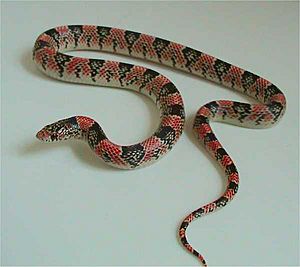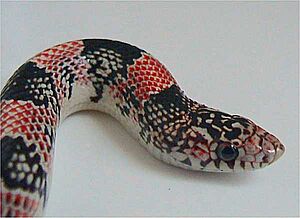Long-nosed snake facts for kids
Quick facts for kids Long-nosed snake |
|
|---|---|
 |
|
| Texas long-nosed snake Rhinocheilus lecontei tessellatus |
|
| Conservation status | |
| Scientific classification | |
| Genus: |
Rhinocheilus
|
| Species: |
lecontei
|
| Synonyms | |
The long-nosed snake (Rhinocheilus lecontei) is a cool snake that doesn't have venom. It belongs to the Colubridae family, which is a large group of snakes. This snake is found only in North America. There are two types, or subspecies, of the long-nosed snake that scientists recognize.
Contents
- What's in a Name? (Etymology)
- Meet the Long-Nosed Snake (Description)
- How They Live (Behavior)
- What They Eat (Diet)
- Life Cycle and Reproduction
- How They Defend Themselves (Defense)
- Where They Live (Habitat)
- Where in the World? (Geographic Range)
- Different Types (Subspecies)
- As Pets (In Captivity)
- More Information
What's in a Name? (Etymology)
The scientific name for this snake, lecontei, honors an American scientist named John Lawrence Le Conte. He was an entomologist, which means he studied insects.
Meet the Long-Nosed Snake (Description)
The long-nosed snake gets its name from its unique snout. It's a bit long and points slightly upwards, like a little shovel!
This snake has three main colors: black, red, and yellow or cream. Its pattern looks a bit like a coral snake, with black and red patches that almost form bands. These patches are on a yellow or cream background. A special feature of the long-nosed snake is the cream-colored spots you can see inside its black patches.
Unlike most other harmless snakes in the United States, the long-nosed snake has scales on its underside near its tail that are not divided. These snakes usually grow to be about 30 inches (76 cm) long.
How They Live (Behavior)
The long-nosed snake is quite shy. It is a nocturnal animal, meaning it is most active at night. During the day, it likes to stay hidden. This snake spends most of its time buried underground, staying safe and cool.
What They Eat (Diet)
Long-nosed snakes are carnivores, which means they eat other animals. Their favorite foods include lizards and amphibians like frogs or salamanders. They sometimes eat smaller snakes too. Occasionally, they might also eat small rodents.
Life Cycle and Reproduction
Long-nosed snakes are oviparous, which means they lay eggs. In the early summer, a female snake will lay a clutch of 4 to 9 eggs. These eggs will then hatch in the late summer or early fall.
How They Defend Themselves (Defense)
If you ever encounter a long-nosed snake, it's not likely to bite you. However, if it feels threatened or gets bothered, it has a special way to defend itself. It can release a foul-smelling liquid and a small amount of blood from its body. This usually makes predators leave it alone!
Where They Live (Habitat)
Long-nosed snakes prefer dry areas. You can often find them in grasslands, especially places that are rocky. They like environments where they can easily burrow into the ground.
Where in the World? (Geographic Range)
You can find the long-nosed snake in many places. They live in northern Mexico, from San Luis Potosí up to Chihuahua. They also live in the southwestern United States. This includes states like California, Nevada, Utah, Idaho, Arizona, New Mexico, southeastern Colorado, southwestern Kansas, Oklahoma, and Texas.
Different Types (Subspecies)
There are two recognized subspecies of the long-nosed snake:
- Western long-nosed snake, Rhinocheilus lecontei lecontei
- Texas long-nosed snake, Rhinocheilus lecontei tessellatus
As Pets (In Captivity)
Long-nosed snakes are not often kept as pets. This is because they can be picky eaters. In captivity, it's easiest to feed snakes rodents, but long-nosed snakes often don't want to eat them. This makes them difficult to care for as pets.
More Information
- Species Rhinocheilus lecontei at The Reptile Database



